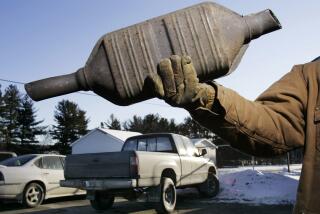Catalytic Solutions Cuts Cost in Slashing Exhaust
When William Anderson, chief executive of Catalytic Solutions Inc., met with venture capitalists this year, their grilling took an unusual twist.
“OK, so how many members of your management team are over 40?” a potential investor asked the 63-year-old entrepreneur, glancing around the table.
“All of them,” Anderson said.
“That’s different,” the investor said. “How many times have you been married?”
“Once,” Anderson said.
“That’s different,” the investor said again.
Catalytic, an Oxnard company that discovered a way to cut the cost of catalytic converters that reduce pollution in automobiles, is very different from a lot of the fledgling companies venture capitalists still see in the post-dot-com-bubble era. Catalytic’s managers are baby boomers and what the company makes isn’t exactly go-go: essentially, it’s something that reduces car exhaust.
But the 7-year-old company has what many investors are looking for these days: a product on the market and a growing revenue stream, not merely an idea on the drawing board and dreams of sales.
“We’re making something that’s getting our hands dirty,” Anderson said. “A few years ago, the venture capitalists would look at us and say, ‘We’ll call you.’ Money was easy to be had, but not by people getting their hands dirty.”
Catalytic also illustrates how the Santa Barbara area has become an important source of investment opportunities in California, thanks in part to the materials technology companies developed by UC Santa Barbara graduates and faculty.
After raising $32.4 million in May in its fourth venture capital round -- one of the largest financings in Southern California this year -- Catalytic is using the money to ramp up its production line as it enters a crucial stage. Since its founding in 1996, the company has raised about $70 million.
Kevin McDonnell, the company’s 42-year-old chief financial officer, said annual revenue runs in the “tens of millions.” He said he expected sales to grow 30% this year and then double in 2004. The company declined to provide specific sales figures.
Of course, for the company to meet its goals of profitability and more than $100 million in revenue by early 2005, things would have to go well next year, McDonnell said.
Still, he said, Catalytic has met with early success. Honda Motor Co., a Catalytic investor, has used Catalytic’s coating product since 2001 in its vehicles made and sold in Japan, McDonnell said, and will use it in vehicles built and sold in the U.S. starting with its 2004 model year. And Car Exhaust Sound System Inc., based in Rancho Santa Margarita, Calif., also is a customer.
General Motors Corp. plans to use Catalytic coating next year in more than 500,000 vehicles for the 2005 model year, said James Brown, senior buyer at the Detroit automaker. Ford Motor Co. also is on board.
“We’re going to watch the launch phase to ensure that the final product is the same caliber as the test parts,” Brown said. “If they are able to prove themselves, the opportunities in the future could be significant.”
Venture capitalists say Catalytic is typical of the kind of company to emerge from the Santa Barbara region.
“One of the things that makes Santa Barbara a unique place is that it has so many experts in the materials process,” said Peter Grubstein, managing director of Ngen Partners, a Santa Barbara-based venture capital firm that invests in materials companies, including Catalytic. Its other portfolio companies include Agile Materials & Technologies Inc., a Goleta-based maker of tunable products for the wireless communications industry.
“It all started 20 years ago,” Grubstein said, “when the university attempted to morph itself from a low-ranking UC campus of surfboards and party kids into something that would be known in [the materials] industry.”
UCSB did so by aggressively recruiting faculty in chemistry, physics and engineering, Grubstein said.
European conglomerates BASF, an investor in Catalytic Solutions, and Unilever, an indirect investor through its stake in Ngen Partners, have opened venture capital offices in the Santa Barbara area, taking stakes in a variety of start-up companies.
Though Catalytic is not a UCSB spinout, its co-founder Stephen Golden, 42, currently chairman and chief technical officer, is a Briton who did postdoctoral work at the university and was immediately smitten with the Southland.
President Daniel McGuire, 52, also is a UCSB graduate, as is Anderson, who worked for 30 years at Santa Barbara-based electronics maker Applied Magnetics Corp., starting as an engineer and retiring as chief executive. Anderson, a self-described “backyard mechanic” and car lover, met Golden at a local networking event in 1995. Anderson liked Golden’s idea of trying a new technology for coating the substrates, or “bricks,” used in catalytic converters -- reducing the amount of platinum needed to produce the components.
Platinum prices have surged 80% in the last two years, making catalytic converters one of the most costly parts of a car.
“Companies have been trying to lower the metal use for years, but you need to do something incredibly radical,” Golden said. “You can’t just rearrange the furniture.”
Golden believes Catalytic’s technology could be applied to other industries -- including gas turbines, agricultural and construction machinery, even snowmobiles -- but the initial focus is on automobile catalytic converters because of the ready market. For Catalytic, the Southern California location also makes sense because of its convenience to Honda’s Torrance plant and Asian shipping, Anderson said.
To hold the attention of the big automakers, Catalytic would have to deliver on its promises on an increasingly large scale to compete with its more established rivals. The $2.5-billion-a-year business is dominated by the likes of Engelhard Corp., Britain’s Johnson Matthey, Umicore of Belgium and Toyota Motor Corp.’s Cataler division.
“Even if CSI’s technology is good, they have to ramp up the manufacturing,” said Jake Balzer, an analyst at brokerage Edward Jones & Co. in St. Louis. “They have to be ready to deliver when the vehicles are being assembled. There is still an ‘unproven’ stigma there.”
Catalytic, which has 130 employees, is gearing up its Oxnard plant to coat as many as 60,000 bricks a week next year.
As a newer player, Catalytic will face pressure to continue to be innovative, Balzer said. Fortunately, carmakers are eager to see another entrant because competition in any business helps drive costs down.
Catalytic “will be around,” Balzer said. “The question is whether they will be around as a real competitor, or just hanging around at the low end of the market.”
More to Read
Inside the business of entertainment
The Wide Shot brings you news, analysis and insights on everything from streaming wars to production — and what it all means for the future.
You may occasionally receive promotional content from the Los Angeles Times.










